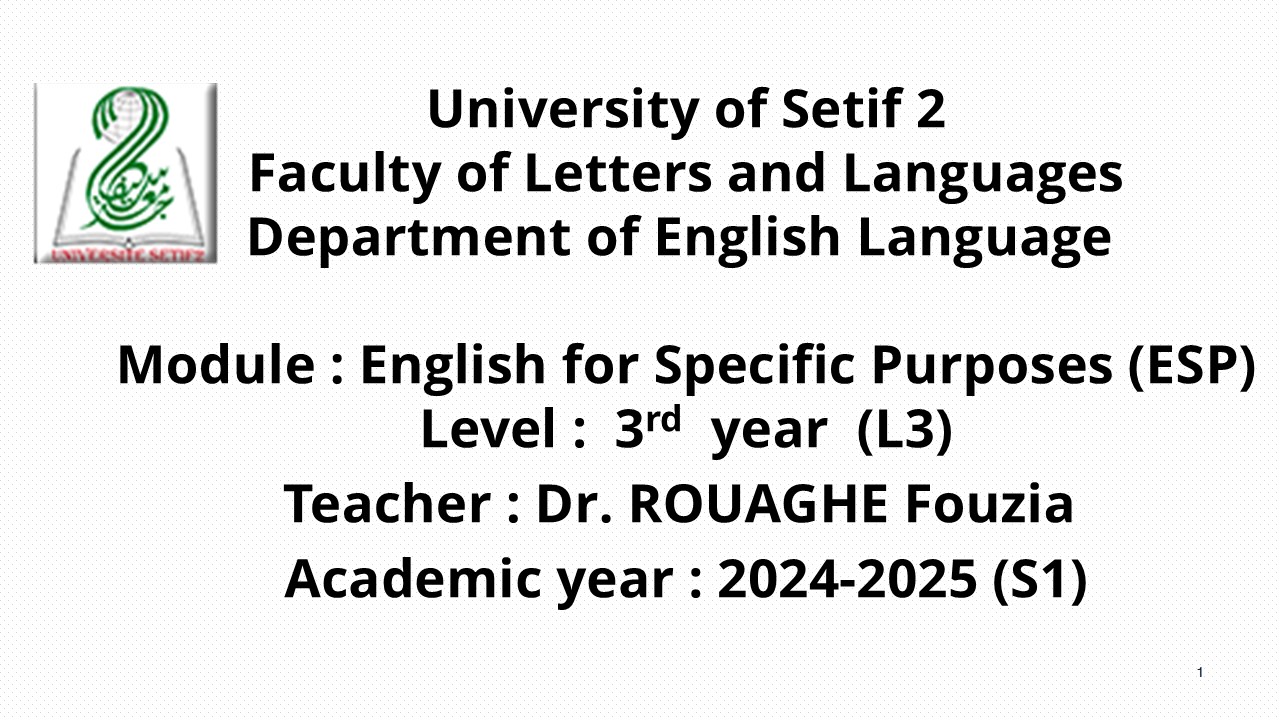
Lecture Summary: English for Specific Purposes (ESP)
Instructor: Dr. Fouzia ROUAGHE
Course Level: 3rd Year Bachelor Degree in English Language 2024-2025
University: Setif 2 University
Lecture 1: Brief History + Origins
This lecture explores the development and evolution of English for Specific Purposes (ESP), tracing its origins back to the mid-20th century. It highlights how ESP emerged as a response to the need for tailored English instruction to meet specific professional or academic requirements, with a focus on practicality and relevance.
Lecture 2: Definitions of ESP
In this lecture, ESP is defined as a branch of applied linguistics that focuses on teaching English tailored to specific fields or purposes. It distinguishes ESP from General English (GE) by emphasizing its specialized nature, catering to learners' specific language needs in various professional, academic, or technical contexts.
Lecture 3: Types of ESP
This lecture covers the different types of ESP, including English for Academic Purposes (EAP), English for Occupational Purposes (EOP), and English for Vocational Purposes (EVP). Each type serves a specific purpose, such as academic research, workplace communication, or vocational skills.
Lecture 4: GE and ESP
The lecture compares General English (GE) with ESP, highlighting the differences in teaching approaches and objectives. While GE focuses on general language proficiency, ESP is goal-oriented, aiming to equip learners with language skills specific to their field of study or profession.
Lecture 5: Grammar in ESP
This lecture discusses the role of grammar in ESP. It explains how grammar teaching in ESP is often context-driven, focusing on structures and patterns relevant to specific disciplines. The goal is to equip learners with the grammar needed for their professional or academic communication.
Lecture 6: Vocabulary in ESP
Here, the focus is on the importance of specialized vocabulary in ESP. The lecture emphasizes the need to teach learners the technical, field-specific terms and phrases essential for their subject area, as well as strategies for acquiring and using this vocabulary effectively.
Lecture 7: Types of Content in ESP
This lecture outlines the various types of content that can be incorporated into ESP courses. These include technical manuals, academic journals, workplace communication materials, and more. The content is tailored to match the learners' professional or academic goals.
Lecture 8: The Role of the ESP Teacher
This lecture highlights the responsibilities of the ESP teacher, who must not only be skilled in teaching language but also knowledgeable about the specific field of the learners. The teacher's role includes designing relevant materials, facilitating language use in context, and adapting to learners' needs.
Lecture 9: Who Should Teach ESP
In this lecture, the qualifications and background needed for teaching ESP are discussed. It emphasizes that an ESP teacher should ideally have both a strong foundation in language teaching and a deep understanding of the specific field in which they are teaching.
Lecture 10: The ESP Learner
This lecture focuses on the characteristics and needs of ESP learners. It outlines the fact that ESP learners are often adults with specific professional or academic goals, and their motivation for learning English is typically task-oriented and driven by the requirements of their field.
Lecture 11: Needs Analysis
This lecture introduces the concept of needs analysis, a key component in designing ESP courses. Needs analysis involves understanding the specific language needs of learners and tailoring instruction to meet those needs.
- معلم: ROUAGHE FOUZIA
